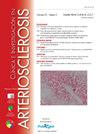动脉粥样硬化性血管疾病的降脂治疗计划。共识秒/海/看到/ SEMFYC森/ SEMERGEN /表/ / SEACV / S.E.N.
IF 1.9
Q3 PERIPHERAL VASCULAR DISEASE
引用次数: 0
摘要
近年来,随着作用于不同代谢途径的新药的出现,我们在降脂疗法方面取得了进展,降低了与含载脂蛋白b (ApoB)的低密度脂蛋白(LDL-C)相关的胆固醇水平和血管风险。然而,实现目标的结果仍然很少,以及使用不同的治疗方法来帮助我们实现这些目标。造成这种情况的原因包括:对血管风险的识别不足、治疗方法的使用不足、推荐治疗的依从性差、在患者随访中角色分配和行动算法方面缺乏组织,以及需要改善教育和社会心理干预,这些都影响到健康生活习惯的依从性和巩固。本共识文件旨在全面改进血脂异常的治疗方法和随访,确定降脂治疗计划作为控制策略(SEC/SEA/SEEN/SEMFYC/SEMERGEN/SEMG/SEN/SEACV/S.E.N.)。本文章由计算机程序翻译,如有差异,请以英文原文为准。
Planificación del tratamiento hipolipemiante en la enfermedad vascular ateroesclerótica. Consenso SEC/SEA/SEEN/SEMFYC/SEMERGEN/SEMG/SEN/SEACV/S.E.N
In recent years we have been experiencing an advance in lipid-lowering therapies, with the appearance of new drugs that act on the different metabolic pathways, reducing both the levels of cholesterol associated with low-density lipoproteins (LDL-C) containing apoprotein B (ApoB), and vascular risk. However, the results in achieving goals are still scarce, as well as the use of the different therapies that help us to achieve them. Among the reasons that justify this situation are: the inadequate identification of vascular risk, the underuse of therapies, poor adherence to the recommended treatment, the lack of organization in terms of the assignment of roles and algorithms of action in the follow-up of patients and the need for improved education and psychosocial interventions that influence both adherence and consolidation of Healthy lifestyle habits. This consensus document aims to improve the approach and follow-up of dyslipidemia in a comprehensive way, defining the planning of lipid-lowering therapies as a control strategy (SEC/SEA/SEEN/SEMFYC/SEMERGEN/SEMG/SEN/SEACV/S.E.N.).
求助全文
通过发布文献求助,成功后即可免费获取论文全文。
去求助
来源期刊

Clinica e Investigacion en Arteriosclerosis
PERIPHERAL VASCULAR DISEASE-
CiteScore
3.20
自引率
6.20%
发文量
44
审稿时长
40 days
期刊介绍:
La publicación idónea para acceder tanto a los últimos originales de investigación como a formación médica continuada sobre la arteriosclerosis y su etiología, epidemiología, fisiopatología, diagnóstico y tratamiento. Además, es la publicación oficial de la Sociedad Española de Arteriosclerosis.
 求助内容:
求助内容: 应助结果提醒方式:
应助结果提醒方式:


